The world of indoor gardening is illuminated with the enchanting presence of “Top 10 Low Light Hanging Plants.” These resilient and visually stunning plants redefine the possibilities of greenery in low light conditions. From the graceful Spider Plant to the exotic beauty of Orchids, each entry in this curated list offers a unique blend of elegance and adaptability. Thriving in the shadows, these hanging plants not only elevate your living space but also bring nature’s touch to even the dimmest corners of your home.
Whether you’re a novice plant enthusiast or a seasoned gardener, exploring the diverse characteristics and care tips of these top 10 low light hanging plants promises to transform your indoor environment into a lush and thriving oasis.
1. Low Light Hanging Plants: Spider Plant
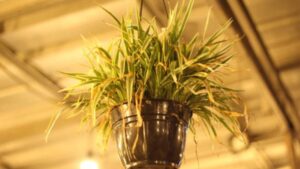
Spider Plants, scientifically known as Chlorophytum comosum, stand out as prime examples of Low Light Hanging Plants. Renowned for their striking arching leaves and spider-like offshoots, these resilient plants hail from South Africa and have gained popularity as top choices for indoor hanging pots. Their adaptability to low light conditions makes them a perfect addition to any dimly lit space, bringing both charm and vitality to your indoor garden.
Caring for Spider Plants:
Spider Plants are relatively low-maintenance, making them ideal for beginners. To ensure their thriving health:
- Light Requirements: While they can tolerate low light, placing Spider Plants in indirect sunlight promotes better growth. They can survive in dim corners but flourish with a bit of natural light.
- Watering: Keep the soil evenly moist, allowing the top inch to dry between waterings. Spider Plants are sensitive to overwatering, so it’s crucial to strike a balance.
- Temperature and Humidity: Spider Plants prefer average room temperatures and can withstand moderate humidity levels. Avoid exposing them to drafts or extreme temperature fluctuations.
- Fertilization: Feed your Spider Plant with a balanced liquid fertilizer every 2-4 weeks during the growing season (spring and summer).
- Propagation: These plants are prolific in producing “pups” or baby spider plants. Propagate by placing these pups in water until they develop roots, then transfer them to soil.
Design Tip: Fashion an eye-catching and elegant display by pairing Spider Plants, distinguished members of Low Light Hanging Plants, with hanging macramé holders. The unique charm of Spider Plants, with their arching leaves, finds a perfect complement in the intricate knots of macramé holders, creating a visually appealing arrangement that stands out in any room.
Consider selecting macramé holders that highlight the graceful foliage of Spider Plants, infusing your indoor space with a touch of natural elegance. Experiment with different macramé designs to craft a personalized and captivating showcase that showcases the beauty of Spider Plants in a stylish and sophisticated manner.
2. Low Light Hanging Plants: Money Plant
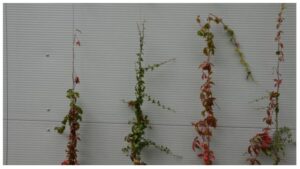
Epipremnum aureum, commonly known as the Money Plant or Devil’s Ivy, holds a special place among Low Light Hanging Plants. Not only is it an aesthetic delight, but it is also believed to bring prosperity according to Feng Shui. Delving into the details of caring for Money Plants ensures that they not only thrive in low light conditions but also fulfill their symbolic purpose, enhancing both the visual appeal and positive energy of your indoor space.
Caring for Money Plants:
- Low Light Adaptability: Money Plants can adapt to low light conditions, making them suitable for rooms with minimal sunlight. However, they do appreciate some indirect light for optimal growth.
- Watering: Allow the soil to dry between watering’s. Overwatering can lead to root rot, so it’s crucial to find the right balance. Water sparingly in the winter months when the plant is in a dormant phase.
- Temperature and Humidity: Money Plants are adaptable to various temperature ranges but prefer warmer conditions. Maintain average room humidity levels.
- Fertilization: Feed your Money Plant with a balanced liquid fertilizer every 4-6 weeks during the growing season (spring and summer).
- Propagation: Money Plants are easy to propagate through cuttings. Simply snip a healthy vine and place it in water until roots develop, then transfer it to soil.
Design Tip: Enhance the prosperity vibes by placing a Money Plant in a decorative pot with coins or crystals at the base.
3. Low Light Hanging Plants: Syngonium

Syngoniums, recognized as excellent Low Light Hanging Plants, are also known as Arrowhead Plants. Beloved for their arrow-shaped leaves and striking colors, these tropical beauties add a lively touch to low light spaces. Their adaptability to diminished light conditions makes them an excellent choice for your indoor garden, where they thrive and contribute to the vibrant, green ambiance. Consider incorporating Syngoniums into your collection for an infusion of charm and color in those shadowed corners.
Caring for Syngonium:
- Light Requirements: Syngoniums thrive in low to medium light conditions. While they can tolerate lower light levels, providing them with bright, indirect light enhances their variegation and coloration.
- Watering: Keep the soil consistently moist but not soggy. Syngoniums are sensitive to overwatering, so ensure proper drainage and allow the top inch of the soil to dry out before watering.
- Temperature and Humidity: Maintain average room temperatures and humidity levels. These plants appreciate higher humidity, so consider misting the leaves regularly, especially in dry indoor environments.
- Fertilization: Feed Syngoniums with a balanced liquid fertilizer every 4-6 weeks during the growing season (spring and summer). Reduce fertilization in the fall and winter when the plant’s growth slows down.
- Pruning: To encourage bushier growth, prune the tips of the plant regularly. This helps Syngonium maintain a more compact and attractive shape.
Elevate the visual allure of your indoor space by incorporating Syngoniums, a beloved variety among Low Light Hanging Plants, into hanging baskets adorned with decorative chains. The cascading vines of Syngoniums create a stunning display, offering a dynamic and visually captivating addition to any room.
Consider selecting hanging baskets with decorative chains that complement the vibrant colors of Syngonium leaves, enhancing the overall aesthetics of your indoor garden. Experiment with different chain designs to achieve a personalized and eye-catching arrangement, infusing your living space with the lively charm of Syngoniums.
4. Low Light Hanging Plants: Boston Fern

Boston Ferns (Nephrolepis exaltata) stand out as exceptional Low Light Hanging Plants, celebrated for their graceful fronds and air-purifying qualities. Flourishing in the cool and humid conditions typical of low light environments, these ferns become an excellent choice for shaded corners. The unique combination of elegance and air-purifying capabilities makes Boston Ferns a standout addition to your indoor garden, effortlessly thriving in the subtler light conditions.
Consider adorning your shaded spaces with the charm and functionality of Boston Ferns for a touch of green sophistication.
Caring for Boston Ferns:
- Light Requirements: Boston Ferns prefer low to medium light conditions. They can tolerate lower light levels, but exposure to some indirect sunlight is beneficial for their overall health.
- Watering: Keep the soil consistently moist. Boston Ferns are sensitive to drying out, so regular watering is essential. Use room-temperature water and avoid letting the soil become waterlogged.
- Humidity: Maintain higher humidity levels to mimic the fern’s natural environment. Regular misting or placing a humidifier nearby can help create the ideal conditions.
- Temperature: Boston Ferns thrive in cooler temperatures, ideally between 60-75°F (15-24°C). Avoid exposing them to drafts or sudden temperature changes.
- Fertilization: Feed Boston Ferns with a balanced liquid fertilizer diluted to half strength every 4-6 weeks during the growing season (spring and summer).
Design Tip: Cultivate a lush and vibrant hanging display by combining Boston Ferns, renowned members of Low Light Hanging Plants, with complementary trailing plants. The pairing of Boston Ferns with other textured plants creates a visual symphony, adding depth and captivating interest to your indoor garden.
Consider selecting trailing plants that complement the delicate fronds of Boston Ferns, fostering a harmonious and visually appealing arrangement. Embrace the interplay of textures to transform your indoor space into a captivating oasis filled with the lush charm of Boston Ferns and their green companions.
5. Low Light Hanging Plants: Monstera Adansonii:

Monstera Adansonii, commonly known as the Swiss Cheese Plant, emerges as a captivating selection within the realm of Low Light Hanging Plants. Recognized for its fenestrated leaves resembling Swiss cheese, this plant brings a touch of exotic elegance to any indoor space. Flourishing in low light conditions, Monstera Adansonii stands out as a unique and eye-catching addition to your hanging plant collection.
The distinctive charm and adaptability of this plant make it a must-have for those seeking a green touch in areas with subtler lighting. Explore the allure of Monstera Adansonii to elevate your indoor garden with a touch of tropical sophistication.
Caring for Monstera Adansonii:
- Light Requirements: Monstera Adansonii adapts well to low light, but it can also thrive in bright, indirect light. Avoid exposing it to direct sunlight, as this may lead to leaf burn.
- Watering: Keep the soil consistently moist but not waterlogged. Monstera Adansonii prefers slightly higher humidity levels, so misting the leaves or placing a humidity tray nearby can be beneficial.
- Temperature: Maintain room temperatures between 65-75°F (18-24°C). Protect the plant from drafts and temperature extremes.
- Support and Training: Monstera Adansonii is a vining plant. Provide a support structure, such as a moss pole or trellis, to encourage upward growth. You can also trim and propagate the plant to control its size and shape.
- Fertilization: Feed your Monstera Adansonii with a balanced liquid fertilizer every 4-6 weeks during the growing season (spring and summer). Reduce fertilization in the fall and winter.
Design Tip: Showcase the distinctive beauty of Monstera Adansonii, a captivating choice among Low Light Hanging Plants, by situating it in a hanging planter with a decorative backdrop. The intricate patterns of the leaves become the focal point of a stunning visual display when paired with a complementary design.
Consider selecting a planter that complements and accentuates the unique foliage, elevating the overall aesthetics of your indoor space. Experiment with different backdrops to create a captivating showcase that highlights the exceptional charm of Monstera Adansonii in your hanging garden.
6. Low Light Hanging Plants: Heartleaf Philodendron
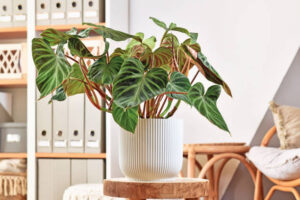
Heartleaf Philodendron (Philodendron hederaceum) takes center stage among the array of Low Light Hanging Plants, cherished for its heart-shaped leaves and remarkable adaptability to diminished light conditions. This charming hanging plant becomes a symbol of cultivating love in the shadows, offering both aesthetic appeal and ease of care.
Let’s delve into the secrets of Heartleaf Philodendron, discovering how its unique characteristics make it an ideal choice for those seeking to infuse their indoor space with love and greenery. Explore the magic of Heartleaf Philodendron to bring a touch of romance to your low light hanging garden.
Caring for Heartleaf Philodendron:
- Light Requirements: Heartleaf Philodendron thrives in low to medium light but can tolerate brighter conditions. Shield it from direct sunlight to prevent leaf scorching.
- Watering: Keep the soil consistently moist, allowing the top inch to dry out between waterings. Heartleaf Philodendron is forgiving of occasional lapses in watering.
- Temperature: Maintain room temperatures between 60-75°F (15-24°C). Protect the plant from cold drafts and sudden temperature changes.
- Propagation: Heartleaf Philodendron is easily propagated through stem cuttings. Snip a healthy stem with at least two nodes, place it in water until roots develop, and then transfer it to soil.
- Pruning: Regular pruning encourages bushier growth. Trim back leggy vines to maintain a more compact and attractive appearance.
Design Tip: Set a romantic tone in your living space by incorporating Heartleaf Philodendron, a symbol of love among Low Light Hanging Plants, into hanging planters adorned with heart-shaped designs. The cascading vines of the Heartleaf Philodendron not only add a touch of natural elegance but also infuse a sense of love and warmth into any room. Consider choosing planters with heart-shaped patterns to further accentuate the romantic atmosphere, creating a charming and intimate ambiance. Elevate the romance in your indoor oasis by integrating Heartleaf Philodendron into thoughtfully designed hanging planters for a delightful and heartfelt touch.
7. Low Light Hanging Plants: Neon Pothos
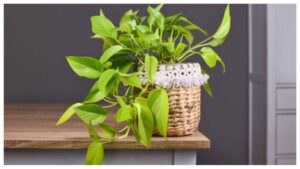
Neon Pothos, a striking cultivar of the Epipremnum aureum family, stands out among the diverse spectrum of Low Light Hanging Plants. With its vibrant chartreuse leaves, this hanging plant not only survives but thrives in dim corners, infusing low light spaces with a burst of color and energy.
The resilience and lively nature of Neon Pothos make it an exceptional addition to your indoor environment, ensuring that even the most shadowed corners come alive with its striking presence. Explore the dynamic charm of Neon Pothos to elevate your low light hanging garden with a touch of vivacity.
Caring for Neon Pothos:
- Light Requirements: Neon Pothos can tolerate low light conditions but prefers medium to bright, indirect light for optimal vibrancy. Shield it from direct sunlight to prevent leaf burn.
- Watering: Keep the soil consistently moist but not waterlogged. Allow the top inch of the soil to dry out before watering again. Neon Pothos is forgiving of occasional lapses in watering.
- Temperature: Maintain room temperatures between 65-75°F (18-24°C). Protect the plant from cold drafts and sudden temperature changes.
- Fertilization: Feed Neon Pothos with a balanced liquid fertilizer every 4-6 weeks during the growing season (spring and summer). Reduce fertilization in the fall and winter.
- Pruning: Regular pruning helps control the size and shape of Neon Pothos. Trim back leggy vines to encourage bushier growth.
Design Tip: Amplify the vibrancy of your hanging garden by incorporating Neon Pothos, a standout among Low Light Hanging Plants, into hanging planters with contrasting colors. The neon leaves of the Pothos plant create a striking visual impact against dark or bold-colored containers, providing a lively and dynamic display. Experiment with different planter hues to accentuate the radiant charm of Neon Pothos and infuse your indoor space with a burst of color. Elevate the aesthetic appeal by embracing the contrast between the vivid foliage and the container, adding a playful and energetic touch to your vibrant hanging display.
8. Low Light Hanging Plants: English Ivy
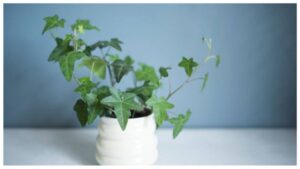
English Ivy (Hedera helix) takes its place among the classic and timeless selections of Low Light Hanging Plants, long associated with elegance in the world of hanging gardens. This trailing beauty brings a touch of sophistication to your indoor space, particularly in low light settings. Delve into the nuances of caring for English Ivy, exploring the specific details that ensure its thriving presence in even the dimmest corners. Discover the enduring charm of English Ivy as it graces your hanging garden with a timeless and elegant allure.
Caring for English Ivy:
- Light Requirements: English Ivy adapts well to low light conditions but benefits from occasional exposure to bright, indirect light. Avoid direct sunlight to prevent leaf burn.
- Watering: Keep the soil consistently moist but not waterlogged. English Ivy prefers higher humidity levels, so misting the leaves or placing a humidity tray nearby can be beneficial.
- Temperature: Maintain room temperatures between 50-70°F (10-21°C). Protect the plant from drafts and sudden temperature changes.
- Fertilization: Feed English Ivy with a balanced liquid fertilizer every 4-6 weeks during the growing season (spring and summer). Reduce fertilization in the fall and winter.
- Pruning: Regularly prune English Ivy to control its size and shape. Trim back unruly vines to maintain an elegant appearance.
Design Tip: Achieve a classic and timeless ambiance by incorporating English Ivy, a quintessential member of Low Light Hanging Plants, into decorative hanging baskets featuring intricate patterns. The cascading vines of English Ivy bring a touch of sophistication to any space, creating an effortlessly elegant look. Consider experimenting with different basket designs to enhance the visual appeal of this resilient plant, adding a timeless charm to your indoor environment. Elevate your décor by embracing the classic allure of English Ivy in beautifully crafted hanging baskets that complement the overall aesthetic of your space.
9. Low Light Hanging Plants: Orchids
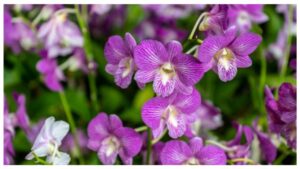
Orchids, synonymous with beauty and elegance, stand out as enchanting members of the family of Low Light Hanging Plants. While traditionally associated with bright, indirect light, it’s noteworthy that certain orchid varieties have adapted to thrive in low light conditions. This unique characteristic makes them a stunning and unexpected addition to your indoor hanging garden, defying the common perception of orchids requiring intense light. Explore the captivating world of orchids as they gracefully enhance the beauty of your indoor space, even in areas with subtler lighting. Embrace the allure of low light orchids for a touch of sophistication in your hanging garden.
Caring for Indoor Hanging Orchids:
- Light Requirements: Choose orchid varieties known for their adaptability to low light, such as Phalaenopsis or Paphiopedilum. Place them in a location with filtered or diffused light to protect them from direct sunlight.
- Watering: Orchids should be watered when the top inch of the growing medium feels dry. Use lukewarm water and ensure proper drainage to prevent waterlogged roots.
- Temperature and Humidity: Maintain room temperatures between 60-75°F (15-24°C). Orchids appreciate higher humidity levels, which can be achieved by placing a tray of water near the plants or using a humidifier.
- Potting Medium: Orchids typically thrive in a well-draining orchid mix. Repot them when the growing medium breaks down, usually every 1-2 years.
- Fertilization: Feed orchids with a specialized orchid fertilizer every 2-4 weeks during the growing season. Use a balanced, water-soluble fertilizer diluted to half strength.
Design Tip: Enhance the elegance of Low Light Hanging Plants, particularly orchids, by situating them in hanging containers adorned with decorative patterns. Elevate the visual appeal by considering the use of transparent or translucent pots, offering a captivating glimpse into the intricate beauty of the orchid’s roots. This design approach not only accentuates the aesthetic charm of the orchids but also adds a touch of sophistication to your indoor space, creating a harmonious fusion of nature and design. Experiment with different container styles to showcase the unique beauty of your low light orchids in a creative and visually pleasing manner.
10. Low Light Hanging Plants: Wandering Jew
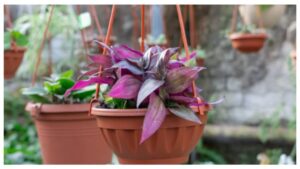
Wandering Jew (Tradescantia zebrina) emerges as a charming and vibrant addition to the family of Low Light Hanging Plants, gracefully adding a trail of green to the dimmest corners of your indoor space. Renowned for its vibrant foliage, caring for Wandering Jew becomes a delightful endeavor, bringing both beauty and a touch of nature to areas with subtler lighting. Explore the unique charm of Wandering Jew as it cascades and thrives in low light conditions, making it a perfect choice for those looking to infuse their indoor environment with lush greenery.
Caring for Wandering Jew:
- Light Requirements: Wandering Jew can adapt to low light conditions but prefers bright, indirect light for optimal growth. Protect it from direct sunlight, which can scorch the leaves.
- Watering: Keep the soil consistently moist but not waterlogged. Wandering Jew appreciates regular watering, especially during the growing season, but allow the top inch of the soil to dry out between waterings.
- Temperature: Maintain room temperatures between 60-75°F (15-24°C). Protect Wandering Jew from drafts and sudden temperature fluctuations.
- Pruning: Regularly trim back the vines to control the size and shape of Wandering Jew. Pruning also helps stimulate bushier growth and a more compact appearance.
- Propagation: Wandering Jew is easily propagated through stem cuttings. Snip a healthy stem with at least two nodes, root it in water, and transfer it to soil once roots develop.
Design Tip: Elevate your indoor oasis by crafting a dynamic hanging display that combines Wandering Jew with other Low Light Hanging Plants featuring contrasting colors. The intertwining vines of these plants not only create a playful touch but also add a visually captivating dimension to your indoor space. Experiment with the vibrant hues and unique textures of Wandering Jew and complementary trailing plants to design a hanging display that transforms your home into a lively and dynamic haven.
Conclusion
In conclusion, cultivating a vibrant and thriving indoor hanging garden with Low Light Hanging Plants is a rewarding endeavor. From the enchanting Spider Plant to the delicate beauty of Orchids, each plant contributes its unique charm to your living space. By comprehending their specific care requirements, incorporating creative display ideas, and adeptly addressing common challenges, you can revel in a green oasis, even in the dimmest corners of your home. Explore the diverse world of low light plants and create an indoor sanctuary that radiates with life and green sophistication.
FAQs
How often should I water low light hanging plants?
Proper watering is crucial for the health of low light hanging plants. While each plant has its specific needs, a general rule is to allow the top inch of the soil to dry out between waterings. This prevents overwatering and helps maintain the right balance for each plant.
Can I use artificial light for my hanging plants?
Yes, artificial light can be an excellent supplement for low light hanging plants, especially in areas with minimal natural light. Use full-spectrum LED or fluorescent lights positioned above the plants. Ensure the light duration mimics natural daylight to support their growth.
What are the best hanging plant display ideas for small spaces?
In smaller spaces, maximize verticality by using wall-mounted shelves or hanging planters. Macramé hangers or decorative hooks allow you to display your plants without occupying valuable floor space. Consider placing smaller plants on shelves to create a layered effect.
Are low light hanging plants suitable for offices?
Yes, many low light hanging plants are well-suited for office environments with limited natural light. Plants like Spider Plants, Pothos, and ZZ Plants can thrive in fluorescent lighting conditions. Ensure you choose plants that match the specific light levels in your office and follow care guidelines to keep them healthy.
How do I prevent pests from affecting my indoor hanging plants?
Preventing pest infestations involves maintaining a clean and healthy environment for your plants. Regularly inspect your plants for signs of pests, clean the leaves to remove dust, and quarantine new plants before introducing them to your collection. If pests are detected, use natural remedies like neem oil or insecticidal soap for control.
